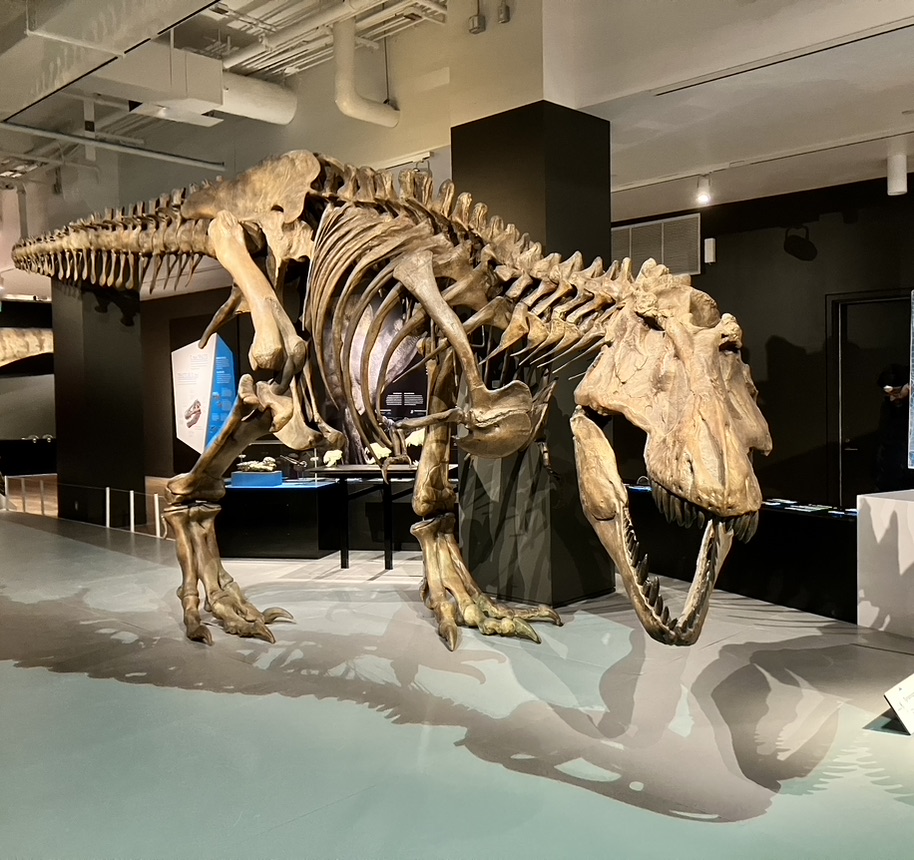Do you love Tyrannosaurus rex and want to know more about it? If so, I have the perfect exhibit for you!
On March 11th, The Royal Ontario Museum opened the doors to its latest exhibition: T. rex: The Ultimate Predator. On tour from the American Museum of Natural History in New York City, The Ultimate Predator is a fascinating journey of growth and evolution. In its halls, we see how both the titular Tyrannosaurus rex and its relatives evolved through the passages of deep history.
The idea of growth is present from the moment you enter the exhibit. The first display is of a baby Tyrannosaurus rex, no more fearsome in appearance and stature than a buck toothed chicken:

Yet looming behind this innocent little rex is the shadow of the monster it will one day become. As the exhibit progresses, we witness how Tyrannosaurus rex went from chicken-sized hatchlings to seven-tonne giants. The model of an awkward, teenage Tyrannosaurus rex midway through the exhibition is a fascinating look at an age demographic not often depicted in dinosaur media. At the end, we see the final form of Tyrannosaurus: a terrifying giant with a face only a mother could love (more on that later).
Running parallel to the growth of Tyrannosaurus is the growth and evolution of the Tyrannosauroid family. The earliest known Tyrannosauroids, small Jurassic carnivores like Proceratosaurus and Dilong, are represented by detailed models. Comparing these early Tyrannosaurids with their later descendants is almost as great a contrast as the different stages of Tyrannosaurus growth! After observing these dinosaurs, we can assert that the Tyrannosauroids came a long way from their humble beginnings in the Jurassic.

Ultimate Predator does a brilliant job of establishing what makes the Tyrannosaurid lineage unique. Their defining anatomical traits are presented in detail, helping viewers understand how a tiny dinosaur like Dilong could ever be related to Tyrannosaurus rex. A graphic displaying the entire Tyrannosauroid family is present near the start of the exhibit, and ten different species of Tyrannosauroids are present. While Tyrannosaurus may be the featured dinosaur, the exhibit is just as much a Tyrannosaurid exhibit as it is a Tyrannosaurus exhibit. While this may be disappointing to some, I believe it works in favour of the overall exhibit quality.
This is not to say that the exhibit lacks Tyrannosaurus content. The Ultimate Predator examines everything from its fecal remains to brain shape and sense of vision, crafting a detailed picture of its life history and physiology. We are informed of some of its most notable controversies (such as the status of Nanotyrannus and the topic of feathers), while others (Greg Paul’s three Tyrannosaurus species) are omitted. There’s nothing necessarily wrong with this; after all, who could expect the exhibit to discuss every piece of Tyrannosaur lore known to man?

After moving to Toronto, The Ultimate Predator added a few new elements. One mount examines Canadian Tyrannosaurids (though it forgot one genus), while another features a recently excavated Daspletosaurus skull from the ROM’s own collections. After seeing updates of the Daspletosaurus quarry for years, it was cool to see the fruits of their labour!
The exhibit culminates in a life-size model of an adult Tyrannosaurus, or as I like to call it, the world’s ugliest T. rex. Overall, the model is astounding and brimming with detail. Its leathery skin is perfectly fleshed out and is superficially reminiscent of elephant hide. While the feathers make the Tyrannosaurus look like a balding 60-year-old, their placement is realistic and not overdone. The brownish-yellow colouration is brilliant, reflecting an animal that likely used camouflage to ambush prey. Lastly, the fact that artificial saliva is present in its mouth shows how above and beyond the exhibit creators went to put it together. But man, it sure is ugly:

Overall, T. rex: The Ultimate Predator is an excellent exhibit that brings new light to everyone’s favourite dinosaur. With detailed models, informative labels, and more Tyrannosauroids than you can get your hands on, Ultimate Predator is a must-see for dinosaur lovers and casual audiences alike.
Besides, who doesn’t want to see the world’s ugliest Tyrannosaurus rex?
Thank you for reading today’s article! If you’d like to visit T. rex: The Ultimate Predator, then read more about it at the ROM’s official website, at the link here! While you’re at the ROM, you should check out the Dawn of Life Exhibit! A once-in-a-lifetime exhibition, Dawn of Life is a must-see exhibition for any paleo fan!
All images are courtesy of the Royal Ontario Museum.

4 replies on “T. Rex: The Ultimate Predator Exhibit Review”
I saw this exhibit when it was at the American Museum of Natural History. Very cool. I liked how they had THE original vertebra specimen that had been found by Barnum Brown on display. However, I wasn’t so pleased with the models – way too shrink-wrapped.
LikeLiked by 1 person
Sounds like a great exhibit especially for those of us who would like to learn more about T Rex. Thanks for sharing!
LikeLike
The original vertebra was quite the sight, though at this point it looks a little worn down! I do agree that some of the models appear a little too svelte (particularly the early tyrannosauroids), but I think the chunky Rex at the end of the exhibit makes up for it a little.
LikeLike
[…] Museum’s latest exhibit, T. Rex: The Ultimate Predator. While I wrote my thoughts about the exhibition in a previous article (spoiler alert: it’s pretty good!), I found selecting images for my article a bit difficult. […]
LikeLike